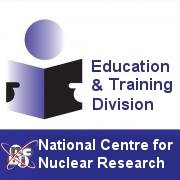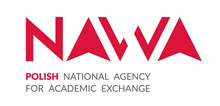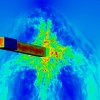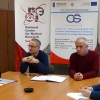Polish/Dutch project in safety analyses of nuclear facilities
2016.12.13 9:29 - adminNCBJ and NRG have just started a joint 3-year-long R&D project concerning safety of modern nuclear power plants. The to-be-researched topics include vulnerability of nuclear reactor vessel walls to temperature shocks. Computer simulations are planned for one year. They are to be done using the 5,000 cluster supercomputer operated in NCBJ Świerk Computer Centre (CIŚ).
NCBJ and Nuclear Research and Consultancy Group, a nuclear service provider located in Petten, the Netherlands (NRG) have just reached an agreement on R&D cooperation concerning safety of modern nuclear power plants.
The project is an enormous undertaking – points out Professor Mariusz Dąbrowski, Head of NCBJ Division of Nuclear Energy and Environmental Studies – The two main research topics include: thermal shocks at high pressures and mixing of coolant inside fuel assemblies.
Safety is a key issue in operation of every nuclear reactor. Engineers and researchers try to predict and analyse even the most improbable, extreme scenarios of emergencies. The results of those efforts find their applications in nuclear industry.
In one of the dangerous scenarios nuclear reactor loses a part of its coolant, which is next supplemented in an emergency procedure with some coolant from Emergency Core Cooling System (ECCS) – explains Eng. Piotr Prusiński, CFD Analyses Team leader in NCBJ Division of Nuclear Energy and Environmental Studies – Stream of cold water from ECCS mixes up with hot coolant within the primary cooling loop. Mixing starts at the injection point i.e. at the reactor vessel inlet valve and propagates towards vessel bottom along the core jacket. Sudden super-cooling may cause stress beyond strength of constructional materials and to reveal defects in vessel walls. Such thermal shocks at high pressures are referred to as Pressurized Thermal Shock (PTS). PTS shocks may challenge the integrity of the reactor vessel, therefore engineers must exactly know the safety limits.
Such topics practically cannot be researched in real facilities in view of very high costs and potential logistic problems in case of a failure (destructive tests). Instead, they are studied by means of numerical simulations, in which real facilities and their constructional materials are modelled mathematically. The models must exactly reproduce every last detail of the simulated facility and every property of the simulated materials. Such detailed and accurate simulations need a huge computing power. Such power is available in NCBJ Świerk Computer Centre (CIŚ). What’s more, analyses of that type are CIŚ specialty since they have been using various Computational Fluid Dynamics (CFD) class software for some time. The CFD software can provide unequalled precision and the highest accuracy of representation of real situations.
Design of safe and optimum fuel assemblies is another subject in the planned NCBJ/NRG cooperation. Inside fuel assemblies coolant flows not only in straight streams along fuel rods, but also turbulently through various inter-rod gaps – that way reducing temperature differences at circumferences of individual rods (a beneficial circumstance from the safety point of view). However, turbulent flow is much less predictable than laminar flow, therefore very sophisticated tools of the CFD methodology are needed to be able to effectively predict evolution of temperatures, flow parameters, and the related uncertainties.
These topics have been widely discussed in the literature, but all so-far used models are based on some difficult to verify assumptions – added Eng. Tomasz Kwiatkowski from CFD Analyses Team in NCBJ Division of Nuclear Energy and Environmental Studies – We would like to get rid of those uncertain assumptions, replacing them with results of simulations faithfully reflecting real flows. They are referred to as the so-called Direct Navier-Stokes (DNS) simulations.
Thorough understanding of physical processes running inside nuclear reactors and knowledge how to model them are the keys to both R&D projects. Petten researchers are very experienced in both reactor physics and reactor operation practice. They are also unquestionable world class experts in modelling of various processes and numerical analyses. Świerk researchers have also been very successful in industrial simulations. Nevertheless, the challenges of the project are formidable. The project will require significant financial outlays, many experts not available either in the Netherlands, nor in Poland, and huge computing power. NCBJ is going to make available for the project its CIŚ computer centre with a 5,000 core computer cluster. The planned project duration is 36 months, of which more than 12 months will be spent to perform necessary numerical simulations. A reference database of knowledge will be one of the project’s outcomes. It will serve to verify simplified models that must be applied in everyday practice in view of a too large complexity of the detailed models (too time consuming to be used routinely). Knowledge acquired by both Polish and Dutch scientists during accomplishment of the project will be its another benefit (science in return).
The project will be financed by both cooperating Institutions from their own means.
Nuclear Research and Consultancy Group (NRG) is a globally recognized nuclear industry consultant and world market leader in the production of medical isotopes. The company conducts research on nuclear technologies, provides consulting in nuclear facility safety/reliability, offers services in radiation protection. The research is usually carried out on assignments placed by various governments. In the Netherlands the company plays a role of a leading centre in integrated radiation protection. NRG operates also the High Flux Reactor owned by European Union. The company is employing about 500 world-class experts of unique know-how, cooperating for and with partners from healthcare, energy, industry, government and science sectors.





















